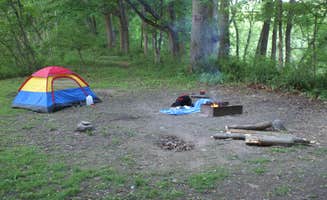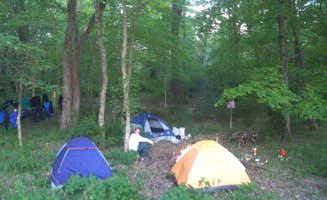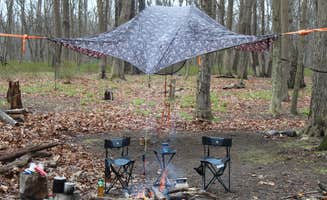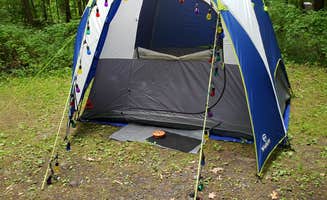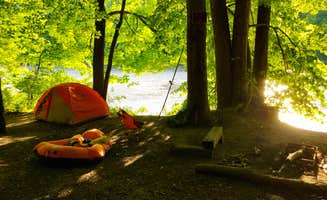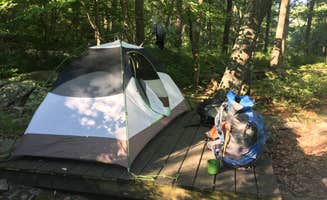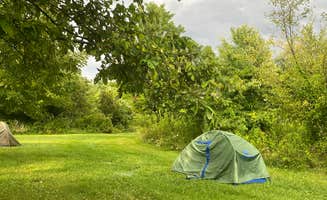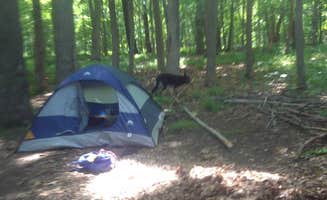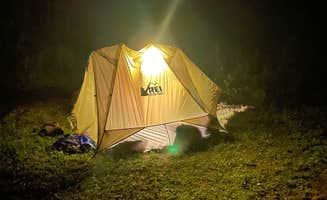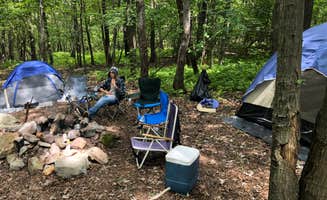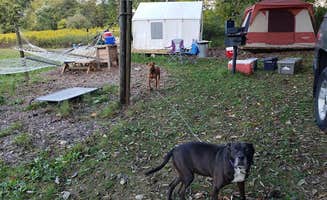Tent campsites near Wallpack Center, New Jersey range from rustic river sites to more developed facilities in state parks. The Delaware River forms the western boundary of this region, with elevations ranging from 300 feet at riverside to over 1,400 feet in the surrounding mountains. Seasonal temperature variations are significant, with summer highs typically reaching the mid-80s while winter temperatures can drop below freezing.
What to do
Waterfall hikes: 1-3 miles round trip. From Namanock Island, campers can easily reach several cascades. As John B. notes, "A short hike takes you to Raymondskill Falls, one of many in easy walking distance, as well as search for abandoned/forgotten homes and mills, some of which date back to the 1700's."
Island exploration: 4 miles downstream from Milford Beach. The primitive camping on Namanock Island offers unique exploration opportunities. According to John B., "Beautiful trails criss-cross the island and not a rock to be tripped over. I do not think I have worn shoes there even once."
River paddling: 12 miles with return options. The river's calm sections make paddling accessible for most skill levels. Derek W. describes one route: "We packed up and set off for another site about 8 miles down the river. After camping at the next site we packed up and hiked back along the McDade Recreation Trail to Dingmans Ferry access where we caught the River Runner Shuttle back to the car in Milford."
What campers like
Complete seclusion: no visible lights at night. Sandyston Boat In Campsites provides an uncommonly remote experience. John B. emphasizes this isolation: "Once darkness falls there are no lights to be seen in either direction, up or down river. You are camped on the side of the island that views Pennsylvania's shore. Now, no lights means an incredible view of the night sky."
Spacious river sites: room for multiple tents. The river camping areas offer ample space. John B. shares about Sandyston: "The sites were very large and while covered by 40+ft trees were open enough to make you wish you brought more gear and people just because it would fit."
Wildlife viewing: deer, birds, and aquatic species. Camping at Steam Mill Campground provides excellent nature observation. Dwight D. reports: "Lots of nature and animal sounds day and night, saw deer, doves, robins, woodpeckers, quail(?), chipmunks, squirrels, skunk(?), and heard frogs."
What you should know
Boat access only: 4-mile paddle required. For river campsites, water access is mandatory. Sean M. explains about Namanock: "Paid $20 for day and overnight parking at Milford beach. Paddle about 4 miles to the site 12, the first site on the right side of nomanock island."
Limited facilities: no drinking water at primitive sites. Bushkill Creek Boat In Campsite and other river sites have minimal amenities. Anna M. notes: "No privy that we found, but a good fire ring and plenty of space for tents. The path up to the campsite from the river gets a little steep, but not bad."
Bear activity: proper food storage essential. Wildlife management is critical in this region. Kristan V. advises at Steam Mill Campground: "There are bears in this area, and while I've not seen one in the campground, I have seen them on the trails while staying here. I store my food in my car overnight and toss garbage bags in the dumpster nightly as well."
Weather considerations: riverside camping vulnerable to water levels. River sites can be affected by weather conditions. John B. cautions: "Spring time trips can find the water levels much higher and swifter making it more difficult to arrive safely, or dry."
Tips for camping with families
Platform tents: easier setup with children. Camp Mohican Outdoor Center offers structured tent platforms that simplify camping with kids. Dan X. recommends: "Tent sites are either on the ground have wooden platforms. Cabins come in various sizes."
Group sites: space for multiple family tents. Larger families or multi-family groups should consider dedicated group areas. Christopher W. describes Rivers Bend Group Campground: "Large field with multiple group campsites with bearboxes, fire pit and garbage cans at each site. Four outhouses centrally located and a pump well."
Lake swimming: alternative to river activities. Families appreciate having swimming options beyond the river. Dan X. notes at Camp Mohican: "Swimming is allowed on Catfish Pond -- plenty of fish, snapping turtles, and other wildlife. If you're there in the summer, I'd recommend taking a kayak around the lake and filling it with wild blueberries."
Cabin alternatives: options for less-experienced campers. For families new to camping, cabins provide a transitional experience. Dwight D. shares about Jenny Jump State Forest: "The 'shelter' is what we would describe as a 'cabin'; four walls, a roof, locking door, locking windows, large picture frame front window, four beds (two bunks), a wood burning stove, and a porch."
Tips from RVers
Site selection: identify flat, accessible spots. RVers camping near Wallpack Center should carefully evaluate campsite terrain. Ethan K. observes about Steam Mill: "Campsite is flat, grassy, some rocks to avoid, one tree in center, large fire ring, picnic table, short walk to the pit toilet, short walk to the water spigot."
Water access: plan for refills at designated spigots. Water management requires planning at camping areas without direct hookups. Kristan V. advises: "If you want to stay remote, be sure to pick up enough fire wood from the office when you check in. They sell the NYNJ Trail Conference Maps, too. It's a ~15 minute drive from the park office to the campground."
Smaller trailers only: site limitations. Most camping areas near Wallpack Center accommodate only compact RVs. Kristan V. notes at Steam Mill: "These sites are for people truly there to camp, either in a tent or small travel trailer."


